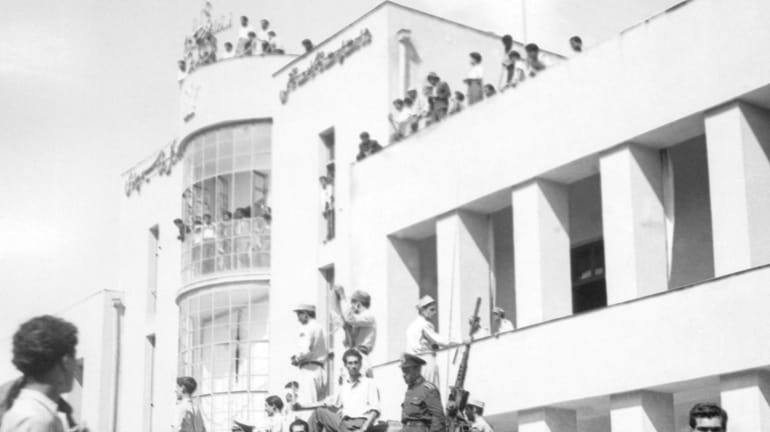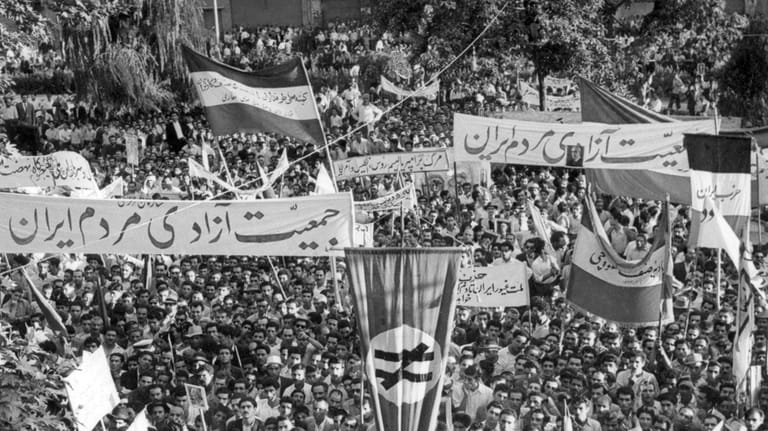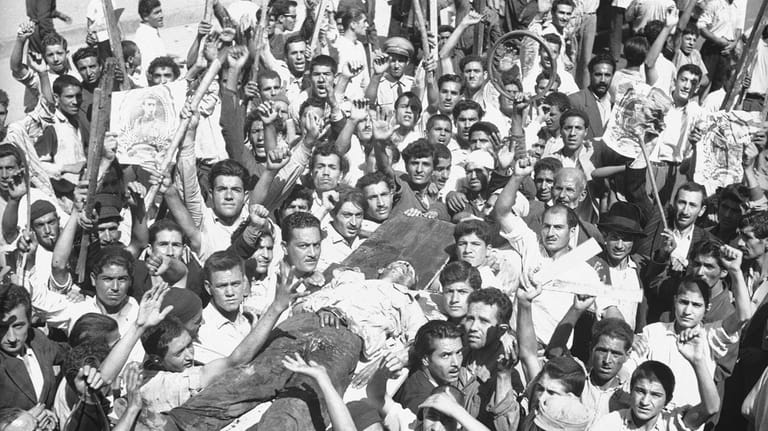AP WAS THERE: A 1953 CIA-led coup in Iran topples prime minister, cements shah's power

FILE -A royalist tank moves into the courtyard of Tehran Radio a few minutes after pro-shah troops occupied the area during the coup which ousted Mohammad Mosaddegh and his government on Aug. 19, 1953. In August 1953, a CIA-backed coup toppled Iran's prime minister, cementing the rule of Shah Mohammad Reza Pahlavi for over 25 years before the 1979 Islamic Revolution. Credit: AP
EDITOR'S NOTE — In August 1953, a CIA-backed coup toppled Iran's prime minister, cementing the rule of Shah Mohammad Reza Pahlavi for over 25 years before the 1979 Islamic Revolution.
The coup, carried out by allied members of its military and security forces, came after then-Prime Minister Mohammad Mossadegh had nationalized the country's oil industry. At the time, Iran's Abadan refinery was the largest in the world and a key supply for Britain, which backed the coup to regain its access.
For the Americans who pushed it forward with millions of dollars in bribes, weapons and other encouragement, the coup represented what Washington at the time saw as the best chance to halt any expansion by the Soviet Union into the Middle East.
At the time of the coup, the public had no idea about the CIA's role in the putsch. That changed in the years after. Kermit Roosevelt Jr., a grandson of former U.S. President Theodore Roosevelt, led the CIA plot from Iran and later even published a book about it.
The American hand in the coup fed the enmity of those who overthrew the shah. And in the years since, the U.S. has avoided declassifying details from government files about it. The State Department in 2017 quietly published details of the coup once expunged from its official history, though some aspects of it remain classified to this day.
At the time of the coup, getting the news out of Tehran saw multiple challenges as well. One newspaper even provided a blow-by-blow account of how The Associated Press filed its first news of the coup but didn't transmit again for hours.
“Apparently the AP dispatch was delayed by censor and transmitted after the government was overthrown," read the Aug. 19, 1953, edition of the afternoon newspaper The Evening Star in Washington, D.C., which carried the latest dispatch at the time transmitted by the clacking teletype machines of the time.

A selection of the huge crowd massed in parliament square after Prime Minister Mohammad Mossadegh announced he had smashed a pro-shah coup d'etat in Tehran, Iran on Aug. 16, 1953. In August 1953, a CIA-backed coup toppled Iran's prime minister, cementing the rule of Shah Mohammad Reza Pahlavi for over 25 years before the 1979 Islamic Revolution. Credit: AP
The AP also relied on several of its main writers of the day, including Nate Polowetzky, who later would serve as the cooperative's foreign editor during his 50-year career.
The stories that follow have been edited for typographical errors but maintain the AP style of the day. That includes spelling Iran's capital city as “Teheran,” as opposed to Tehran, giving the prime minister's first name as Mohammed instead of Mohammad and naming the shah as Mohammed Reza Pahlevi, as opposed to Mohammad Reza Pahlavi.
The initial report also cites claims made on the radio that then-Foreign Minister Hossein Fatemi had been “torn to pieces,” though he actually had gone into hiding. Authorities arrested him months later and executed him by firing squad after a military court trial.
Iranian premier reported ousted by mob

The body of a man killed in a pro-Shah riot which swept through Tehran is carried aloft by demonstrators on Aug. 19, 1953. In August 1953, a CIA-backed coup toppled Iran's prime minister, cementing the rule of Shah Mohammad Reza Pahlavi for over 25 years before the 1979 Islamic Revolution. Credit: AP/Aziz Rashki
TEHERAN, Iran, Aug. 19 — A royalist uprising in Premier Mohammed Mossadegh’s army and police flared in Teheran today with pitched battles in the center of the city. The first determined efforts of police and troops loyal to Shah Mohammed Reza Pahlevi to capture the central police headquarters was beaten off by a hail of shots.
(Teheran radio broadcasts received in London said the shah’s supporters had overthrown Mossadegh and sent him fleeing for his life and that mobs had “torn to pieces” his foreign minister, Hossein Fatemi. The broadcast called upon the shah, who is in Rome, to return.)
Hundreds of shots were fired over the heads of demonstrating mobs in Sepah Square.
Pro-shah mobs burn at least eight buildings in the center of the city before the demonstration crystallized into armed attacks by loyalist police and troops on key positions, such as the foreign ministry.
The terse broadcast picked up in London gave no details of the reported upset in Tehran and cables from there were shut off or badly delayed so there was no immediate confirmation.
Dispatches filed earlier from Teheran this morning told of mob violence and police gunfire in the capital.
But these accounts said the disorders were caused by police efforts to halt nationalist supporters of Mossadegh and Communists from continuing frenzied demonstrations against the shah.
Iran’s handsome 33-year-old ruler, Shah Mohhamed Reza Pahlevi, fled from the country with his beautiful queen, Soraya, last Sunday when Mossadegh’s forces crushed an attempt to oust the old premier and install the shah’s choice – a pro-western general, Fazollah Zahedi. The shah and queen arrived in Rome yesterday.
The report from Teheran today said Zahedi had been installed as the new premier.
Hawk-nosed, weepy old Mossadegh rode to power in April 1951, on his powerful nationalist demands for government seizure of the vast 30,000,000-ton a year oil industry from the British, who had controlled the country’s life blood for half a century.
His refusal to compromise in his program nationalizing the $1,500,000,000 Anglo-Iranian Oil Company shut off the flow of oil to the West and caused a bitter break in diplomatic relations be-tween Iran and Britain.
The shah and his queen were eat-ing lunch at their Rome hotel when they heard the report of the over-throw. Excitedly, the shah said he was eager to return to his country.
The man who read the invitation to the shah over Teheran radio said:
“At this time the people have been able to capture the capital. We are eagerly waiting for your re-turn.”
Before this the first announcement of the royalist overthrow of Mossadegh followed much confused shouting in the radio station, according to monitors in London.
Tabriz radio in Azerbaijan — the province adjacent to the Soviet Union — said it was in the hands of shah supporters. It also reported that all army garrisons in Azerbai-jan had sided with the shah.
But the radio at Isfahan, 200 miles south of Teheran, stood by Mossadegh.
Teheran radio contained a plea to the population to keep calm. A major came on the air and said:
“Listen, I am an infantry officer who has been retired by Mossadegh the traitor. We have proved to the world that the Iranian army is the protector of this country and is under the command of the shah.”
A woman’s voice called on the Iranian people “to prove that foreigners cannot capture the country,” and added:
“Iranians love the Shah. Mossadegh is sending your country to the government of the hammer and sickle.”
Mossadegh has kept a vise-like grip on Iran for more than two years. He has repeatedly crushed opposition to his regime, whether it has come from parliamentary rivals, religious leaders or the palace.
Once only did he give up the premiership. That was when Ahmed Qavam took over the government. But Qavam lasted only three days before rioting supporters of Mossadegh swept him out of office.
The latest revolutionary bid may yet turn out to be shortlived because the nationalist-minded Mossadegh still commands tremendous support in the bazaars and in the slums of Iran’s sprawling, teeming cities.
One other main factor seemed unsettled: Just how long will the Communist Tudeh Party hold its hand?
The Reds in the view of most western diplomats, are the best knit, most coherent political organization in the country. For months they have aligned themselves with Mossadegh in his row against the palace. It may be that they will act now —especially if it seems that any new regime may be ready to stamp out their party, which officially is illegal.
The Teheran broadcasts were picked up here by monitors of the British Broadcasting Corporation. All normal outside communications channels with Teheran were cut.
The British Foreign Office rushed the radio reports to Prime Minister Churchill at his country home in Kent, but said it had no confirmation of the coup.
Monitors here said a welter of confused shouting accompanied the reading of the first communique from Teheran.
The shouting apparently was a row over who should read the announcement.
One voiced: “Let me read it.” Another: “No — I want to read it.” Then came a voice of reason: “It doesn’t matter who reads it as long as it gets read.”
The royalist broadcast built up a picture of complete victory, with Mossadegh fleeing for his life.
The reference to Fatemi being torn to pieces was not elaborated upon. But presumably this meant the foreign minister had fallen into the hands of a royalist mob.
There also was no elaboration of where and how Mossadegh escaped.
British officials still were waiting to see if pro-Mossadegh mobs would take to the streets. They thought the issue might be settled in clashes in squares of the capital.
Shah, in Rome, eager to return; people behind him, he says
ROME, Aug. 19 — The Shah of Iran said today he would return to his country immediately if reports of the overthrow of the Mossadegh government prove true.
The 33-year-old Shah was dining in his hotel when Tehran radio reports were brought to him.
He jumped up excitedly, bit a cigarette nervously, and said: “Please let us know more. I want confirmation. I want to fly back immediately.”
Shown the report from the Tehran radio, the Shah said it appeared that the Iranian military had engineered the overthrow.
“Col. Pahlovan must be a member of my family,” he said. “My country doesn’t want the Communists and therefore has been faithful to me.”
The Rome telephone exchange said communication lines to Tehran stopped abruptly this morning, but that it had not been told the reason.
While waiting tensely for further news, the Shah said that he planned before his flight last Sunday to go to Azerbaijan, in northern Iran.
“I wanted to go there and organize a new government and march on Teheran and Mossadegh,” he said. He made these plans, he went on, “when I was told that the action of my guards had failed and that the commanders had been arrested and my palace occupied.
“But having reflected on it I thought my action would certainly create bloodshed, and that is a thing I wanted to prevent at all costs.
“Therefore, I went to Baghdad (Iraq) to be in a place as near as possible to my country. I planned to remain there until the inevitable thing, which happened today, occurred.
“However, I was forced to leave because of the Queen’s health. So we went to Rome where the Queen has many friends.”
The green-eyed 20-year-old Queen sat next to the Shah on a divan while he sat in his shirtsleeves telling the story of the flight. She sipped mineral water nervously.
“I know that 99 per cent of the Iranian population is behind me and for the liberty of the nation. Any one not a Communist is faithful to me and the monarchy,” declared the Shah, who fled his Middle Eastern kingdom after an early attempt to unseat Premier Mohammed Mossadegh failed.
The royal couple brought only three suitcases here on their flight from Baghdad. One contained the Queen’s personal jewels.
Asked if the famous “Mirror of Light” diamond was among them, the Shah said, “No. I gave that to my country long ago.”
The Iranian crown jewels have been held in Teheran’s Bank Melli for a number of years and reportedly have been used as partial backing for the national currency.
The couple was accompanied here by the Shah’s personal pilot, Mohammed Khatami and Abolfat Attabay, a personal attache of the ruler.
Pro-Mossadegh Teheran mobs may decide the issue in Iran
By Nate Polowetzky
Associated Press Foreign Correspondent
LONDON, Aug. 19 — The brawling, screaming mobs of the Teheran streets and bazaars may now hold the destiny of Iran in their hands.
While old Premier Mohammed Mossadegh is still alive, the issue remains unresolved.
Reported ousted today, only two days ago he apparently still commanded the fanatical sup-port of the little merchants in the bazaars and the street brawlers armed with rocks and sticks.
For the past year and a half, with minor exceptions, he has had the backing of the strong and well-organized outlawed Tudeh (Communist) Party, the most powerful single political group in Iran.
Unless Mossadegh overnight lost all this support, or unless the army revolted en masse and arrested all the old man’s chief lieutenants, it is difficult to imagine Mossadegh going down without a fight to regain his power.
For more than 50 years the wily Mossadegh, fighting always in opposition, struggled to seize power in Iran. After having had it for more than two years he is not going to give it up easily.
In July 1952, I saw the mobs put Mossadegh back in power after he had resigned in a dispute with the Shah and had been succeeded by his ancient rival, the 82-year-old Ahmed Qavam.
First there were the demonstrations in front of the Parliament Building, innocent appearing at the beginning. Then out of the sleazy bazaars and slums the mobs came, shouting “Death to Qavam,” “Death to the Shah,” “Mossadegh or Death.”
They stormed through the sweltering streets stoning the police, smashing windows dis-playing pictures of the Shah, tearing their clothes, pushing their bare breasts up against the pointed bayonets of the troops Qavam had sent into the streets.
Many of them died. Their comrades smeared their shirts in the blood of the dead, dragged the corpses through the streets and still battled the soldiers, swarming over tanks and always screaming for Mossadegh, who remained in his home behind high walls on a quiet Teheran street.
All through the day and into the night the mobs roamed the streets — burning, pillaging, shouting — until finally Qavam resigned and the Shah recalled the troops to their garrisons.
Then the crowds descended on Mossadegh’s home, their eyes burning with fanatical fire, and shouted hosannas for the old man.
It happened then — and it could happen again.
In those days, however, Mossadegh also had the backing of Ayatullah Kashani, the British-hating, intensely nationalist old religious leader, whose assassins and hoodlums paved the way for Mossadegh’s original appointment as premier.
But the two apparently split over Mossadegh’s piecemeal assumption of total power in Iran.
The big question now is where does Kashani stand — for Mossadegh or for the Royalists?
Kashani is as shifty as a piece of quicksilver. Despite his recent conflicts with Mossadegh, who threw him out of office as speaker of the Majlis (Parliament), Kashani has never been a lover of the Shah.
Last February, when Mossadegh’s quarrel with the Shah over rule of the army came to a head, Kashani sided with the Shah. Kashani mobs chased Mossadegh in his pajamas and he had to flee his house.
But Mossadegh’s partisans came into the streets and gradually got the upper hand in demonstrations before the Parliament Building.
